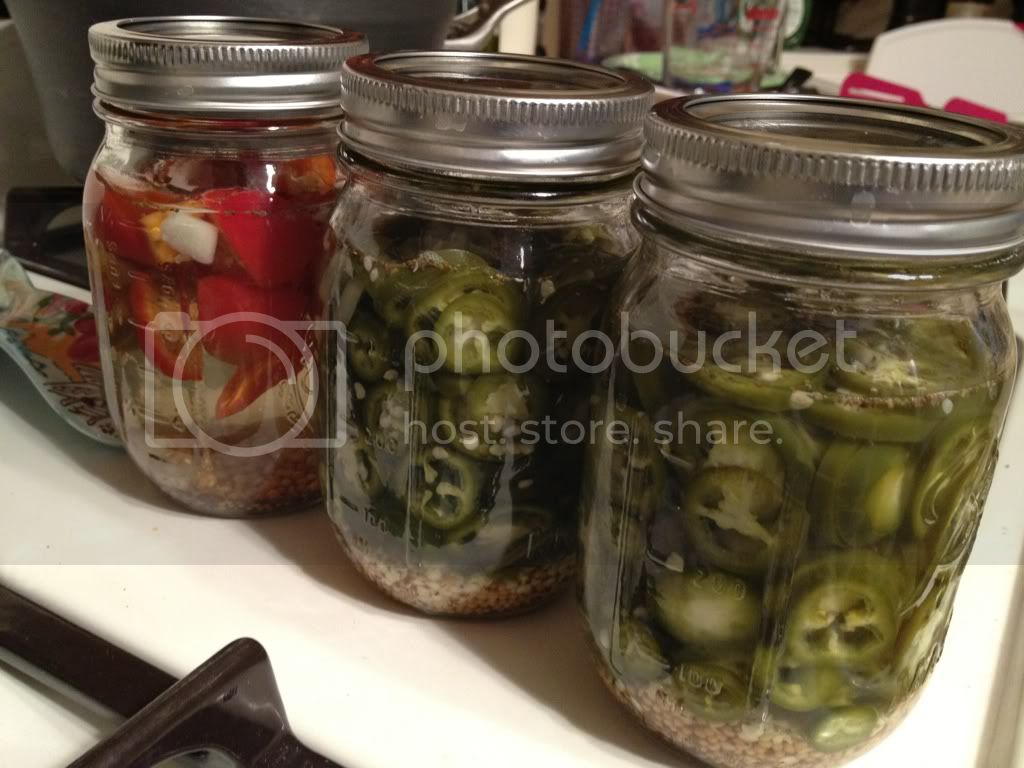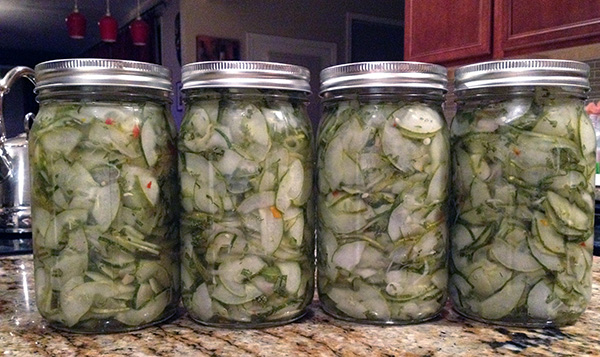I will get it in a minute--have to nurse my youngest to sleep. She's a cranky little girl.
Is pressure canning just used for a long shelf live?
When I decide to pickly my peppers how long do they normally stay good for if refridgerated?
I've had my fermented pickles and other fermented goodies last for at least 6 months in the fridge, although its usually all consumed way before then.
Sour pickles(adapted from the book Wild Fermentation)
Fermentation time: 1-4 weeks(depends on how sour you want them to get)
Equipment needed:
Ceramic crock or food grade bucket--I used a 1 gallon glass jar left over from store bought pickles
plate to fit inside crock or bucket(I didn't use the plate for my 1 gallon batch)
jug filled with water to weigh down plate or baggies filled with water--need this to keep the pickles under the brine to ferment, otherwise you will get mold developing
cloth cover--I used a flat fold cloth diaper to cover, but you can use an old towel as well
Ingredients(yields approx 1 gallon):
3-4 pounds/(1.5-2kg) cucumbers(recipe calls for them to be used whole, but I cut them in half)
3/8 cup/(6 tablespoons) per half gallon(2 liters) of water for brine solution
3-4 heads fresh dill or 3-4 tablespoons any combo of dill(fresh/dried/seeds)
2-3 heads of garlic, peeled(I roughly chopped mine up so I can get more garlicky flavor)
1 handful fresh grape or oak leaves
pinch of whole peppercorns
* I also added a pinch of whole allspice berries as well as some fresh anise, which gives it a unique bit of flavor
The recipe doesn't call for any hot peppers, but I chopped up a few handfuls of hungarian hot wax, and jalapenos as that is all I had on hand at the time.
Directions:
1) Thoroughly wash cucumbers, making sure to remove any of the blossom ends
2) Dissolve sea salt/kosher salt in 1/2 gallon(2 liters) water to create brine
3) In clean crock, place in the bottom dill, garlic, grape or oak leave, peppercorns, allspice, chopped peppers and any other spices you want to add.
4) Place cucumbers in crock--I cut mine in half lengthwise since I was inpatient
5) Pour brine over cucumbers, place plate on top, weighing down with a jug or bag of water. If water doesn't rise over the cucumbers, make more brine at a ratio of just under a tablespoon of salt to 1 cup of water.
6) Cover with a cloth to keep out dust, flies, etc. Store in a cool place.
7) Check every day. If a white mold appears on surface, scrape it off. Rinse of plate and weight and replace. Taste after a few days to see if they are to your liking.
8) Enjoy the pickles as they continue to ferment, checking every day, and tasting as you go along.
9) In about 1-4 weeks, depending on the temperature, they should be fully sour. When they are to your liking, move to the fridge to slow the fermentation and enjoy.
*I don't actually measure out the cucumbers spices--just loosely follow the recipe. I do make sure that the brine is made as directed. The first batch I made, I had them fermenting in my kitchen, and since our house is quite warm in the summer(only have a few window a/c's) they got nicely fermented in about 4-5 days, nice and sour, garlicky and spicy. They have a flavor somewhat reminiscent to the claussen refrigerated pickles, but about 100x better. I have almost finished up the 1 gallon jar, have a 5 gallon bucket going in the basement which is close to being done, and then I will start another batch next time with zucchini from the garden since its growing like crazy.
*my second batch which is still going-I just started it about a week ago, I am using a 5 gallon food grade bucket with lid that has an o-ring for a tight seal, a dinner plate weighed down with a gallon jug filled with water. I covered the top with some plastic wrap and secured the lid on almost all the way, leaving it open just a bit to vent, and I burp it once a day to release any gases. I did the same with my fermented sauerkraut which turned out great.
This book can be found online as a pdf download if you google it. Many more recipes for fermenting, including for other veggies, breads, wine, etc.



